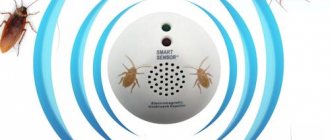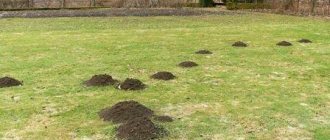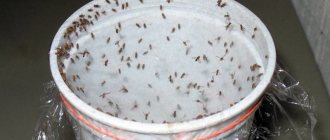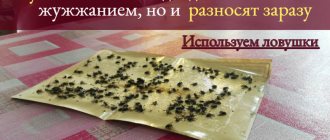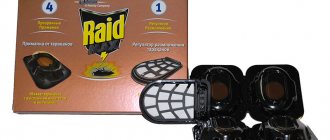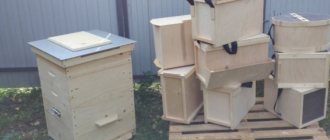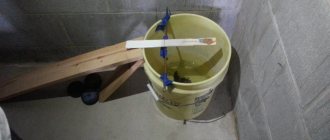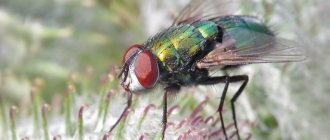14.01.2016
Wasps that appear on a suburban area cause a lot of trouble for the owners. They can start under the roof, in the attic or even in the house. These insects pose a threat of human bites, which can subsequently cause allergic reactions. In addition, wasps spoil the harvest of fruits and berries.
- Purpose of traps for wasps
- Types of wasp traps
- Types of bait in traps
- How to make your own insect trap from a bottle
- Light based wasp trap
- Advantages and disadvantages
Wasp trap
Why wasps are dangerous to humans
Wasps multiply very quickly and, without hesitation, fly into houses and feast on fruit.
At the same time, they feel like masters and bite people. It is the bites of these insects that are dangerous, as they contain a strong active poison that causes allergic reactions. In some people, bites even provoke anaphylactic shock. Wasps are considered the most dangerous for young children, because they have not yet developed protective reactions. Therefore, if unwanted neighbors appear in the form of biting insects, you should definitely take measures to eliminate them. Making a wasp trap from a plastic bottle
How wasps behave
Wasp and its prey.
At the beginning of the season, females, fertilized in the fall, wake up and will become queens - the builders of the house and the founders of the whole family. They begin to build the first rows of honeycombs and lay offspring.
Closer to mid-summer, a large number of aggressive, young individuals appear. They continue to build and look for food for the larvae. That's when they are the most dangerous.
Plastic bottle trap
How to make something useful for your home from a 5-liter plastic bottle
The optimal and most effective way to combat wasps is to destroy their nests on the site, but not everyone has this opportunity. Many have no choice but to make their own wasp traps from a plastic bottle with their own hands and place them around the site to protect themselves and the sweet harvest. This is the simplest option and accessible to everyone.
On a note. Experts recommend using plastic containers with a volume of at least 1.5 liters to make wasp traps.
To complete this you will additionally need:
- Construction knife;
- Drill or awl;
- Scotch;
- Wire.
The conical part is cut off from the bottle. The cork is twisted, the conical part, neck down, is inserted into the cylindrical one. Holes are pre-made in the latter for fastening to the tree. You should not fasten the conical and cylindrical parts of the bottle with rope or wire, as this will make it difficult to open the bottle when you need to remove insects.
DIY wasp trap
Interesting. Tape and wire are needed to secure this simple device to the trunk so that the trap can withstand the wind.
It is important to consider that the trap must be located in a well-lit area to allow the bait to wander. It is also worth providing a small roof for the device. It can also be made of plastic, or of another material. A roof is needed to protect the bait bottles, as the first rainfall may cause the main bottle to be filled to the brim and need to be replaced.
What to do with a rat trap and a caught rat
Of course, a person is no longer a medieval barbarian, but in relation to a caught rat, there is only one solution - liquidation. This can be done as follows:
- add water to the container so that the animal drowns;
- a precise blow to the head with something like a bat;
- shoot the pest if you have a suitable weapon;
- if it is possible to transfer the animal into a sealed container, you can send the “criminal” to the gas chamber. Mix soda and vinegar in a cup, pour into a container, the animal will suffocate (this is considered a humane method of punishment).
The methods described seem terrible, but a person cannot, like the Pied Piper of Hamelin, control animals with a pipe, so there are simple methods of elimination.
Still, the best way would be to choose a trap that does not cause any injury to the animal and subsequently release it away from the area.
The process of making and using a wasp trap
Even a schoolchild can make the planned trap. 1. Using a sharp knife or scissors, cut off the top of the plastic bottle in a circle at the point where it begins to turn into a cylindrical shape (about 1/3 of the container in height). 2. Pour red wine into the larger part of the bottle to about 15 mm from the bottom and add two or three more drops of dishwashing liquid to enhance the smell of the bait. 3. Turn the neck 180 degrees and insert it into the base of the larger part of the bottle at the top. It will serve as a funnel through which the wasps will penetrate into the bottle, but will no longer be able to get out of it. Before inserting the neck into the bottle, remove the cap from it and fix it to the base using transparent tape. 4. We place the finished trap near wasp nests and observe how it works. If the result does not suit us, then the homemade device must be moved to another place until the effect appears in the form of wasp individuals regularly falling into the trap. 5. As the trap is filled with dead wasps, they must be removed from there, the device must be washed, disinfected and, after refilling, placed in those places where wasps appear. The bodies of dead insects should be disposed of, for example, buried in the ground, otherwise their smell will attract more and more wasps from the area closest to the house. 6. The fight against a wasp nest can be considered completed when the wasp queen, which is larger in size compared to other wasps, is discovered and destroyed.
How to check effectiveness
The first wasps should be trapped within a few days. Then it will be clear that it works well. If the bottle remains empty, you need to change the location or filling.
If the bottle is full, you need to carefully empty it. It is just very important that all the insects inside are dead, otherwise they will be very aggressive. Moreover, they will pass on information about the danger to others.
Corpses need to be disposed of properly - they release a substance that attracts others. Therefore, they need to be buried or drained into the sewer.
Pros and cons of homemade traps
Devices in the fight against wasps compare favorably with their analogues, because:
- environmentally friendly than other chemical insecticides;
- safe with a simple structure and no use of toxic substances or poisons as bait;
- universal, because can be installed anywhere: garden, room;
- accessible due to the possibility of self-production at minimal cost;
- easy to use;
- do not have a negative impact on bees;
- multifunctional, because once you have made a trap you can use it repeatedly for wasps, flies, moths, and mosquitoes.
A wasp trap is a temporary distraction and will not be able to completely and permanently protect your home or cottage from hordes of insects. This is a minus.
You will also need to periodically check the container, clean it from pests, and dispose of them. It is equally important to prepare an attractive bait and replace it as insects eat it.
Safety precautions
Hanging trap.
It must be remembered that it is better to avoid all contact with wasps. They, especially when they feel threatened, become aggressive. If there are any living individuals left, you will need to wait or shake the bottle a little so that everyone is in the water. Carry out cleaning in a timely manner!
Safety precautions must be followed:
- Place traps in a secluded place.
- Unload only dead insects.
- Make sure no bees get in there.
- Do not use toxic substances.
Advantages of homemade structures
DIY traps. have a number of advantages:
- Cheapness. All of them are made from a bottle or other used plastic container.
- Environmentally friendly. They use natural products as bait rather than toxic chemicals.
- Ability to cover large areas. Such traps can be placed in any necessary place.
- Energy independence. They do not require batteries or an electrical connection to operate.
- Ease of maintenance. It is enough to empty the container from time to time and dispose of pests.
But it should be borne in mind that it will not be possible to get rid of all wasps in this way, but it is quite possible to secure your home or dacha for a while.
What are the best baits to use?
Making a trap for wasps is half the battle. You need something to attract you. To help - baits with an appetizing aroma and a strong odor. Insects must fly and purposefully go into the trap.
It’s easy to make treats yourself from what you have on hand:
- Liquid honey (1 tbsp) per glass of water.
- Fermented fruit compote or syrup (30 ml) with the addition of 1 glass of white wine and honey.
- Light beer (0.5 l), sugar (2 tbsp. l).
- Wine vinegar (70 ml), water (0.5 l), granulated sugar or honey (2 tbsp. l).
- Jam diluted with water.
For the bait to work effectively, the smell must spread far beyond its boundaries. It is better to use a potion made from fermented products or speed up the artificial fermentation process by mixing a cocktail of jam, water, and wet yeast (1 pinch). It is recommended to place the composition not only in the trap, but also to lubricate the funnel-shaped part. The main thing is that the bait is sweet. Although in practice, mash, kvass, watermelon juice, meat, sausage, and food waste containing protein work flawlessly.
Wasps instantly flock to the beer, although the drink quickly disappears. But it is not advisable to use honey. It attracts not only wasps, but also bees.
On a note! It is not recommended to pour fresh jam or sugar syrup into the trap. Such baits are attractive to bees, but garden pollinators should not be destroyed. As bait, you can use not only spoiled or odorous products, but also poisonous purchased substances (Get, Lambda Zone, Delta Zone). Effective baits work flawlessly, are odorless, are used sparingly, and cause rapid death of insects.
Prevention is better than cure
Even if the problem of wasps in the garden is foreign to you at the moment, you need to think about how to prevent it in the future.
- The easiest way to ensure your safety and protect your home, gazebo or balcony is to impregnate all wooden surfaces with environmental impregnation.
- Cover any holes with a mesh with a cell width of 3x3 mm. An imitation of a wasp nest attached to the ceiling or wall is also well suited for these purposes. It will also scare away uninvited guests.
- This option is quite bold, because there are few of us who voluntarily want to hang in our house, albeit a fictitious, but still a hornet's nest.
- Make sure that trash cans are tightly sealed to prevent insects from eating. Install liquid traps everywhere to catch wasps.
Garbage cans must not be left open.
When a wasp removes its sting, a specific smell is released, which serves as an “invitation” to other wasps and even a whole swarm to attack.
Wasps belonging to the species Dinocampus coccinellae lay eggs in ladybugs! And this is just the beginning. The wasp lays eggs in empty spaces in the ladybug's abdomen and for 20 days the larvae feed on the ladybug's tissues. A cocoon is formed between her legs. The immobilized cow protects herself and the larvae with all her might. Only 25% of ladybugs emerge unharmed after such a test and return to normal life, as discovered and proven by scientists from the University of Montreal and Montpellier.
Methods for wasp bites from the 15th century
- · Wrapping with mallow leaves.
- · Lubricating the bite site with laurel oil.
- · Lubricate the affected area with vinegar and salt with the addition of honey.
- · Use geese droppings.
Unlike talk, wasp venom has a neutral, not alkaline, pH of 6.8 - 6.9, and is not used in the treatment of diseases.
Wasps are controversial insects. On the one hand, they bring clear benefits by destroying pests in the garden plot. On the other hand, this is not the best neighborhood for a person. Aggressive, they bite painfully and have a very toxic venom. There are many ways to protect yourself from meeting them. One of the most effective and safest is a wasp trap made from a plastic bottle. It is easy to make it yourself, thereby protecting your yard from uninvited guests.
Types of bait in traps
Most often, a honey solution is used as bait - 1 tablespoon per full glass of water. Or it could be diluted jam - it’s better when it starts to sour slightly. It is also acceptable to use beer or fruit compote.
One of the baits for wasps
The following bait solution recipes are considered the most popular for traps:
- 2 full tablespoons of granulated sugar and half a liter of beer;
- Mix 3 full tablespoons of granulated sugar or honey with 70 ml of wine vinegar, and dissolve the resulting mixture in half a liter of water;
- Mix sweet white wine with honey or granulated sugar and 30 ml of mint syrup.
The baits listed suggest that the traps will emit a strong aroma that actively lures wasps. For this purpose, a hole is cut at the top of the trap, which will not allow the insect to escape outside, but will spread the smell even close by. In addition, when filling the trap, its conical part should be heavily doused with bait, this will help make it even more effective.
How to make it yourself
Devices for catching and destroying slugs can not only be purchased at the store, but also made with your own hands, for example, from a plastic bottle.
To catch pests you will need:
- 2 liter plastic bottle;
- scissors;
- beer.
Manufacturing technology
The idea is to place a small amount of yeast-based alcohol in the garden. The slug bar should be covered with a lid to protect it from precipitation. Slugs love the aroma of yeast and, once trapped, drown or die from alcohol intoxication. Every day more and more “alcoholic” snails will accumulate in the trap. As it becomes filled with pests, it is cleaned and filled with new bait.
The easiest way to make traps for slimy parasites is from an ordinary 2-liter plastic bottle.
- Take a container and cut out 2 square pockets in the shape of the letter “P”. They should be located opposite each other.
- Bend the pieces of plastic down to create slides. This will make it easier for slugs to get inside the trap.
- Place the bottle on a small hill, covering the edges of the steps with earth. The entrance must remain open.
- Fill the bottle with beer and the “bar” is ready.
Check the trap periodically to see how many pests have accumulated in it. Remove any slugs you encounter and add alcohol as needed.
The trap should not be placed where there is maximum damage to plants by slugs.
Please use caution. Attracted by the beer aroma, snails will begin to make their way from the entire area directly into the “tavern”
And along the way they will come across lush vegetation, which requires protection. The pests will get everything at once - both the drink and the snack.
But the goal is to repel slugs from those places where they can cause the most damage, to reduce the overall number of pests in the garden. Place traps away from valuable plants. Let there be tough vegetation nearby that pests cannot handle.
It is better to use an inexpensive beer drink. Sour leftovers or dough prepared with yeast in small quantities are suitable. It doesn't hurt to add a little honey to the alcohol to enhance fermentation and aroma. But this is optional.
If beer drink and dough are not available, mix 0.5 teaspoon of granulated sugar with flour. Add half a teaspoon of simple yeast to it. All components must be dissolved in a glass of water. Slugs will like this bait no less than beer. But sometimes the absence of alcohol slightly reduces effectiveness.
A homemade slug trap can also be made from watermelon rinds. Slugs have an excellent sense of smell. They can pick up an attractive scent from a long distance. If the area where the food is located is dark and damp, they will stay there until the food is gone.
To make such a trap you will need half a watermelon without pulp. You need to make 3 to 4 holes in the peel. At dusk, place the watermelon upside down in the garden. In the morning there will be several dozen slugs trapped in the trap. The watermelon trap can be used several nights in a row.
Self-production
By taking a little time and using available tools, you can make a homemade wasp trap. There is no need to buy special materials and tools: what is available in almost every home will come in handy.
The most primitive option is to pour a sweet solution with a pleasant smell into a saucer or spread it on plywood. Insects attracted by the bait will land on the surface and remain stuck to it forever. But such a tar will have to be replaced frequently. Therefore, it is recommended to find half an hour to make larger structures. After all, knowing how to make a trap for wasps, you can save money: there is no need to spend money on purchasing it.
To protect the area from insects, one trap will not be enough. It is better to make 4 pieces and hang them in the corners of the perimeter of the site or evenly distributing them throughout its territory.
The simplest version of a trap
To make it, you only need a large plastic vessel (you can take a light canister or 5 liter bottle of drinking water) and a knife. Having opened it, pour in a sweet liquid: you can make a bait for wasps with your own hands by diluting jam or honey in water. Fermented compote is also great.
All that remains is to close the container and make a small hole in the lid with a knife. Its diameter should be about the size of a coin so that wasps can climb into the trap. If a canister is used, a hole can be made in its upper part. The bait is placed in the garden or hung by the carrying handle that 5 liter bottles have.
Funnel trap
A simple, but - most importantly - effective option for making a wasp trap from a plastic bottle is available to everyone. You can use containers with a volume of 1.5 liters or 5 liters (if a large number of insects are annoying).
As experience has shown, it is better to take a bottle made of transparent or light plastic: wasps fly into them more readily than into those made of dark material.
To make the design you will need:
- a plastic bottle is the basis for a homemade salting bottle;
- sharp knife or scissors;
- awl;
- scotch;
- wire or rope about 50 cm long.
All these tools are available, perhaps, in every household. When they are ready, you can start making a wasp trap with your own hands:
- First you need to take a plastic bottle and cut off about one third from the top. To do this, use a sharp knife or pruning shears. You need to act carefully so as not to get hurt.
- Bait is poured or placed in the lower part. Therefore, you need to think in advance about what to put in the wasp trap.
- The upper cut off part will be the “entrance” to the trap for flying insects. The lid is unscrewed, turned over to form a kind of funnel, and inserted into the base with the bait.
- Now you need to make a fastening: make 2 holes located opposite each other in the walls of the plastic bottle and thread a wire or rope into them. You can tie knots on their edges and pass them through the bottle with a large loop.
- To enhance the spread of the aroma attractive to wasps for bait, several small holes are created in the walls on each side using an awl. The air circulating through them will be filled with a sweet smell and attract insects into a deadly trap.
All that remains is to hang the structure in the chosen place and wait until it is filled with wasps. Over the course of a day, it can accumulate about 100 individuals.
Design with 2–3 funnels
By analogy with the previous version, a similar model is made, but from several bottles. Holes for fastening and 2-3 holes are made in the main ones, and the necks are cut off from the rest. They are inserted into the incisions. The result is a structure similar to a trunk with branches. As with the creation of other products, liquid is poured inside to trap wasps.
Purchased products: types, prices and reviews
If you don’t want to bother making a wasp trap yourself, then you can easily buy one. For example, the following models are actively sold in agricultural stores or online today:
- Wasp Trap is a wide plastic trap with a clear top and colored bottom. It has special entrances directed inward and upward, and the wasps that are inside can no longer find these entrances. The Wasp Trap has a convenient mount for hanging on branches, and costs about 400 rubles.
- Swissinno, Swiss made trap. Works much the same as the Wasp Trap, but looks like a neat little bucket. Sold already with bait that does not attract bees. It also costs about 400 rubles.
- GUARD'n CARE, made in China by order of a Dutch concern, is a product with several compartments of different widths. Costs about 350 rubles.
All of these traps are quite effective, and the price does not reflect their quality. You can buy either the one that is cheaper and easier to deliver, or the one that is in stock (we recommend giving preference to the Swissinno trap).
Review
“We suffered from wasps this summer. They made a nest in the fence at the dacha, and my daughter and I arrived a day before my husband. Well, on the very first day we were bitten once. I called my husband, he arrived with a purchased trap. This is a bucket with holes on the sides. They hung it right next to the nest and poured sweet compote into it. The wasps were caught for several days until the entire trap was filled, but this was not much use. The rest were flying anyway. It ended with my husband dousing their nest with gasoline at night and burning it.”
Yana, Kirov
Traps
Full traps are much more effective than tape. Making a wasp trap with your own hands is quite simple. There are 3 main types, each of which has dozens of modifications.
- Electric wasp fighters.
- Traps with liquid.
- Cylinders designed for the insect's instinct to fly exclusively upward.
The mechanism for manufacturing electric fighters is complex and will require not only a large amount of time to create a working apparatus, but also a certain level of knowledge. However, its effectiveness is no better than in other cases. The only advantage of an electric trap is that there is no need to clean and remove dead insects.
Due to the complexity of manufacturing and the lack of advantages over other types of traps, they will not be considered further. The focus will be on simple and reliable tools.
Trap made of plastic bottles
Traps made from plastic bottles are very easy to make and use. They are durable and reliable. But to quickly achieve your goals, you will need several of these products.
To create the design you will need:
- 2-3 liter plastic bottle or jar.
- scissors.
- a piece of wire for hanging.
- tubes with a diameter of up to 1 cm and a length of 2-3.
- tape or tape.
Now you can begin the process itself.
- Cut off part of the bottle with scissors, approximately 7-10 cm from the neck.
- Set the top aside; you will need it at the end.
- Make 5-10 holes in the bottom of the bottle, at a height of more than 5 cm.
- Insert the tubes into the holes. Glue a piece of tape or tape on the inside.
- Insert the top of the bottle with the neck down.
- Make 2 holes for fastening the structure.
- Pull the wire through the mounting holes.
- That's it, all that remains is to pour the bait onto the bottom.
Why can't insects get out?
Wasps live by instinct. They completely lack independent intelligence and thinking. Once inside the structure and having had enough, the insect begins to fly along the wall, but cannot fly out. Hitting the top of the bottle, the wasp falls back down. She ends up drowning in the bait.
What are tubes for?
When the number of dead representatives of the wasp family begins to cover the entire surface, blocking the passage from the neck to the sides, the individual that has just flown in will easily get out of the trap. But if she crawls inside through the tube, she won’t be able to get back out.
It would seem that it is enough to clean the trap regularly and there will be no need to make holes and insert tubes. This is done for other reasons. Firstly, when leaving for the city for a week, you will not need to remove the traps. The number of individuals destroyed will be much greater. Secondly, wasps are sensitive to smell. Thanks to the ventilation created by the tubes, the smell from the bait will spread over a considerable distance. The effectiveness of the bait and the trap as a whole increases.
Glass jar and straws
The basic principle of operation is no different from the above option, but instead of a plastic bottle, a glass jar is used. How to make such a trap?
- Roll up the jar or put a reusable lid on top.
- Make holes in the lid.
- Insert the tubes into the holes, but so that the top is less than a centimeter.
- Pour the bait into the jar.
Just in case, tape is placed on the inner end of the tubes.
The cylinder and the action of light
It has already been said that wasps are not capable of reasoning and problem solving. Instincts drive these insects. One of them is a wasp flying towards the light. This property underlies another trap design, which you can make yourself. To do this you will need:
- a dark cylinder without a base (for example, a canister with a cut off bottom);
- old sieve or fine mesh;
- tubes;
- scotch;
- knife or scissors.
Having collected everything you need, you can start creating.
- Seal one base with mesh or secure an old sieve. There should be no gaps between the cylinder walls and the base.
- Make holes near the opposite base.
- Attach tape to the tubes. The result should be something like a valve.
- Insert the tubes with the valve inside the cylinder.
- The trap is ready.
How does a cylindrical trap work?
The bait is placed on a flat surface. For these purposes, use bricks or cinder blocks. Now the bait is covered with a cylinder, with the net towards the top. Wasps crawl through the tubes into the structure. If you set the trap in an open area, and not in the shade of trees, then the insects will try to fly out through the upper base, covered with mesh. They will not go down and try to crawl out. All that remains is to inject Dichlorvos or another toxic substance into the product at the end of the day. After use, the cylinder is rinsed and it is ready for use again.
What's the best way to catch insects?
The principle of operation of purchased traps, domestic or foreign, is no different from those made by yourself - placing the bait inside. They are used:
- in residential premises;
- at catering establishments;
- in educational complexes;
- in recreational areas (park areas, boarding houses);
- on agricultural land.
It is best to place wasp traps in the spring, because at this time only young individuals fly. If they are caught in a timely manner, the entire “family” will die. People are most annoyed by wasps at the end of summer, but during this period traps only work as a limiter on the number of insects.
When catching, to avoid being bitten, you should take safety measures.
Contact with insects is possible only when there is complete confidence that they are all dead. Particular care should be taken when checking traps located near wasp nests. In general, it is better to install them no closer than twenty meters from housing. It is mandatory to use protective equipment - at least rubber or cotton gloves. Modern manufacturers offer traps that differ in size and design, but the mechanism remains standard, so if you do not want to make the device yourself, you can purchase it in a specialized store
In the fight against wasps, you can use sticky fly strips, which are hung in different places throughout the territory. They are inexpensive and easy to use, but beneficial insects can also stick to them. Another means of protection is a homemade insecticide based on mint essential oil: add 15 drops of oil to a glass of water and spray the room. Contact with exposed areas of the body is completely harmless.
Modern manufacturers offer traps that differ in size and design, but the mechanism remains standard, so if you don’t want to make the device yourself, you can purchase it at a specialized store.
In the fight against wasps, you can use sticky fly strips, which are hung in different places throughout the territory. They are inexpensive and easy to use, but beneficial insects can also stick to them. Another means of protection is a homemade insecticide based on mint essential oil: add 15 drops of oil to a glass of water and spray the room. Contact with exposed areas of the body is completely harmless.
Electric trap bait
There are several types of magazine mechanisms:
- l Simple mechanisms, inexpensive, require bait to be placed inside the trap.
- l Traps containing ultraviolet lamps. Insects fly into their light and encounter a grid through which current passes. Their cost depends on the manufacturer. Thus, traps produced in the Czech Republic, Sweden, and Holland are of high quality, but they are more expensive than devices from domestic or Chinese manufacturers.
Bee trap
Simple store-bought traps also require bait. For these purposes use:
- A sweet syrup made using sugar or fruit juice.
- Sweetened water.
- Honey water.
- Meat, better if it is spoiled, or sausage.
Important! Not only sweet smells can attract wasps, but also foods containing protein.
A little about the bait
To choose a bait that will really work, you need to understand the life cycle of these insects.
in spring
The emergence of queens begins in the spring. They lay the first larvae and feed them protein. This is when food of animal origin is needed. Then fat and meat waste are used as bait.
in autumn
In the second half of summer and early autumn, wasps need a large amount of food in order to stock up on nutrients for the winter. Therefore, they are lured with sweet drinks.
Sticky wasp trap
If a wasp family has settled near the house, in the wall, in outbuildings, and periodically flies into the house, you can catch them using sticky fly tape. Hang it on the windows, near the door.
In the apiary, in the garden, in the yard they use a homemade sticky trap for wasps. You can make it in 5 minutes. To make it, you will need a base - a piece of plywood, oilcloth, plastic, wood or other durable material on which glue can be applied.
They buy a special non-drying glue that is used to catch cockroaches at home and ants in the garden. A suitable remedy is Clean House, Viola, RaTrap. Apply to the surface with a minimum distance between strips. It takes about 120 g of glue to make one trap. The finished structure is hung on a tree, wall, or any suitable place.
On a note!
The main disadvantage is that not only wasps, but also other insects can fall into the trap. In rainy weather the trap quickly loses its properties.
Glue trap for insects
Possible harm from wasps in the garden
Wasps are a significant obstacle to safe and comfortable outdoor recreation and living in suburban conditions. Insects feed not only on plant juice and fruit pulp; they are attracted to many foods, fresh fish and meat. They can actively search for rot in garbage cans and gather in clouds over carrion. They should be feared because they carry many infectious diseases.
Apiaries especially suffer from wasp infestations: they not only look for sweets, but also kill bees - they feed their larvae with them; at least 6-7 traps are needed throughout the entire territory. Their bites are painful and can become a source of infection with pathogenic microflora or severe allergies, including anaphylactic shock.
Wasps live in highly organized colonies, the numerous inhabitants of which are constantly in need of food, and there is a high probability of causing significant damage to the harvest of garden beds and fruit crops. Thanks to the presence of intelligence, insects use warnings of danger; they protect relatives by swooping in as a swarm. During the warm months, colonies increase rapidly, so it is important to exterminate them near houses where there are children.
Poison trap
If you don’t have time to prepare the structure, but you need to get rid of wasps, you can use any fruit or poison. The easiest way to kill annoying insects. Suitable baits include watermelon, melon, grapes, ripe apples, and aromatic pears. Cut in half so that insects can easily access the juice.
The poison is used without odor so as not to repel pests. Any dust is suitable, powder - boric acid, Clean House, as well as liquid products Lambda Zone, Delta Zone. All that remains is to choose a suitable place and leave the bait. A photo of such a trap can be seen below.
If catching pests does not save the situation, you need to start looking for a nest on a plot of land or cottage and get rid of it.
What to do if wasp traps don't help?
In exceptional cases, even with the constant capture of a large number of wasps, their number in the area may not seem to decrease. In such situations, you either just have to wait until the grapes or raspberries go away, or find their nest in the vicinity and destroy it.
In high-density gardening communities, wasps will almost certainly take up residence on someone's property. By going around your neighbors, you can eventually find the “lucky one” who has their nest, or often several at once, hanging in his attic or closet. In addition, in apiaries or in the vicinity of abandoned areas, you can catch a couple of wasps with leather gloves, tie scarlet ribbons around their abdomen, release them and watch where they fly. In just half an hour you can find their nest.
Sources
- https://7ogorod.ru/prochee/lovuska-dla-os-iz-plastikovoj-butylki.html
- https://SdelaySam-SvoimiRukami.ru/5231-kak-sdelat-jeffektivnuju-lovushku-dlja-os-iz-plastikovoj-butylki.html
- https://GdeKlop.ru/osy-i-pchely/samodelnyi-lovushki/
- https://MrKlop.ru/zhalyashhie/osy/kak-sdelat-lovushku-dlya-os.html
- https://bezbukashek.ru/sredstva/lovushki-dlya-borby-s-osami
- https://beetlestop.ru/lovushki-dlya-os/
- https://klopkan.ru/osy/delaem-lovushku-dlya-os/
- https://7ogorod.ru/prochee/lovuska-dla-os.html
- https://apest.ru/osy/kak-izbavitsya-ot-os/lovushki-dlya-os/
- https://klop911.ru/shershni-i-osy/osy/lovushka-dlya-os.html
[collapse]
Why do midges appear in an apartment?
As a rule, any insects appear in an apartment due to poor sanitary conditions. Basically, it appears in the summer, when ideal conditions are created for its reproduction. Why do they appear? It is not difficult to assume that insects appear in conditions where they are attracted to something.
Midges are attracted to:
- Leftover food left on the table.
- High humidity.
- Inadequate sanitary conditions.
Therefore, objects that attract midges in an apartment are considered:
- Uncleaned food remains on the dining table, as well as garbage in the trash can.
- Increased humidity due to improper watering of indoor plants and flowers.
- The remaining tea leaves, which some housewives like to water flowers with, believing that it replenishes the plants with nutrients. As a rule, after this it begins to rot and attract insects.
- A cat litter that is not cleaned on time.
- Pieces of food stuck in the kitchen sink drain.
- Poor care of pets associated with untimely replacement of spoiled food.
- Food products that are stored in the wrong place begin to disappear.
- Fruits and vegetables left on the table. Some apartment owners like to leave fruits and berries in a vase on the table.
- The presence of wet rags in the kitchen or bathroom, especially if they have been left unwashed for several days.
- Dampness caused by condensation or due to faulty water supply systems.
What harm do midges cause?
They are very annoying, making a person aggressive. They spread infection, which you should pay special attention to. Harmful to indoor plants. They crawl on food and cutlery, leaving various pathogens on them. Pets chase them and damage furniture and curtains. Midges can bite very painfully, leaving behind inflamed areas on the human body.

